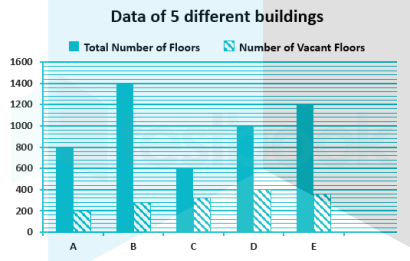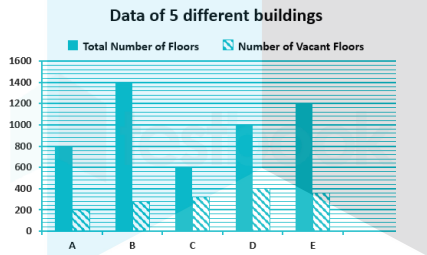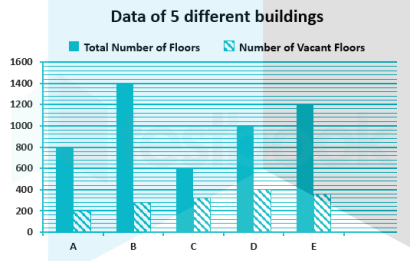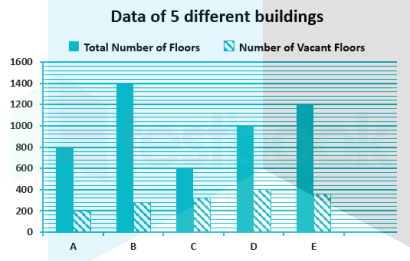Directions: There are 5 different Buildings A, B, C, D and E and the number of Total number of
floors and number of vacant floors given. Read the graph carefully and answer the given questions

Total Number of floors = Number of Vacant Floors + Number of Occupied floors
The number of occupied floors in building C is what % (approx) less than the number of vacant
floors in building E?
0.22
0.28
0.26
0.3
Step by step video & image solution for Directions: There are 5 different Buildings A, B, C, D and E and the number of Total number of floors and number of vacant floors given. Read the graph carefully and answer the given questionsTotal Number of floors = Number of Vacant Floors + Number of Occupied floorsThe number of occupied floors in building C is what % (approx) less than the number of vacant floors in building E? by Maths experts to help you in doubts & scoring excellent marks in Class 14 exams.
Similar Questions
Directions: There are 5 different Buildings A, B, C, D and E and the number of Total number of floors and number of vacant floors given. Read the graph carefully and answer the given questions

Total Number of floors = Number of Vacant Floors + Number of Occupied floors
The number of occupied floors in building C is what % (approx) less than the number of vacant floors in building E?View SolutionDirections: There are 5 different Buildings A, B, C, D and E and the number of Total number of floors and number of vacant floors given. Read the graph carefully and answer the given questions

Total Number of floors = Number of Vacant Floors + Number of Occupied floors
Find the ratio between number of occupied floors in building B and that of building E.View Solution
Knowledge Check
- Question 1 - Select One or More
Number of floors in a building.
Then the random variable isAnot continuousBnot discreteCcontinuousDdiscrete
Directions: There are 5 different Buildings A, B, C, D and E and the number of Total number of floors and number of vacant floors given. Read the graph carefully and answer the given questions

Total Number of floors = Number of Vacant Floors + Number of Occupied floors
Find the average of total number of occupied floors in all the 5 buildings.View SolutionDirections: There are 5 different Buildings A, B, C, D and E and the number of Total number of floors and number of vacant floors given. Read the graph carefully and answer the given questions

Total Number of floors = Number of Vacant Floors + Number of Occupied floors
If 3 persons live on each occupied floor of building A and 2 persons live on each occupied floor of building D, then find the total number of persons living in these 2 buildings.View SolutionDirections: There are 5 different Buildings A, B, C, D and E and the number of Total number of floors and number of vacant floors given. Read the graph carefully and answer the given questions

Total Number of floors = Number of Vacant Floors + Number of Occupied floors
Find the difference between the total number of occupied floors of building B and C together and that of buildings D and E together.View SolutionStudy the following information carefully and answer the questions given below:
Ten people live in three buildings namely A, B and C. Building A is to the immediate left of building B whereas building C is to the second right of building A. A maximum of four people live in a building.
Note: Immediately above or below implies that the person is not in the same building.
As many floors are there below the floor, in which T lives, as it is above the floor in which Y lives. There are four floors above the floor in which S lives. S doesn’t live in building B but lives at floor number 5. Z lives in that floor number, which is the sum of the floor number in which R and S live. The sum of the floor number in which P and T lives is 3 and both lives in different building. R lives in building B and lives at the topmost floor. T and Y live in same building but they do not live in building A. The sum of the number of the floor in which T and V lives is equal to the floor number in which Y live. T lives in the even numbered floor. Equal number of floors are there below the floor in which Q lives and above the floor in which W lives. There are two floors between W and Q. U lives on that floor number which is immediately below the floor number in which V lives. Only Two people live in Building C. S and U live in same building. R lives immediately two floor above the floor in which S lives.
How many floors are there in building A, B and C respectively?View SolutionStudy the following information carefully and answer the questions given below:
Ten people live in three buildings namely A, B and C. Building A is to the immediate left of building B whereas building C is to the second right of building A. A maximum of four people live in a building.
Note: Immediately above or below implies that the person is not in the same building.
As many floors are there below the floor, in which T lives, as it is above the floor in which Y lives. There are four floors above the floor in which S lives. S doesn’t live in building B but lives at floor number 5. Z lives in that floor number, which is the sum of the floor number in which R and S live. The sum of the floor number in which P and T lives is 3 and both lives in different building. R lives in building B and lives at the topmost floor. T and Y live in same building but they do not live in building A. The sum of the number of the floor in which T and V lives is equal to the floor number in which Y live. T lives in the even numbered floor. Equal number of floors are there below the floor in which Q lives and above the floor in which W lives. There are two floors between W and Q. U lives on that floor number which is immediately below the floor number in which V lives. Only Two people live in Building C. S and U live in same building. R lives immediately two floor above the floor in which S lives.
Who among the following lives on the second floor of building A?View SolutionStudy the following information carefully and answer the questions given below:
Ten people live in three buildings namely A, B and C. Building A is to the immediate left of building B whereas building C is to the second right of building A. A maximum of four people live in a building.
Note: Immediately above or below implies that the person is not in the same building.
As many floors are there below the floor, in which T lives, as it is above the floor in which Y lives. There are four floors above the floor in which S lives. S doesn’t live in building B but lives at floor number 5. Z lives in that floor number, which is the sum of the floor number in which R and S live. The sum of the floor number in which P and T lives is 3 and both lives in different building. R lives in building B and lives at the topmost floor. T and Y live in same building but they do not live in building A. The sum of the number of the floor in which T and V lives is equal to the floor number in which Y live. T lives in the even numbered floor. Equal number of floors are there below the floor in which Q lives and above the floor in which W lives. There are two floors between W and Q. U lives on that floor number which is immediately below the floor number in which V lives. Only Two people live in Building C. S and U live in same building. R lives immediately two floor above the floor in which S lives.
How many persons live between the floor on which Z and P live?View SolutionStudy the following information carefully and answer the questions given below:
Ten people live in three buildings namely A, B and C. Building A is to the immediate left of building B whereas building C is to the second right of building A. A maximum of four people live in a building.
Note: Immediately above or below implies that the person is not in the same building.
As many floors are there below the floor, in which T lives, as it is above the floor in which Y lives. There are four floors above the floor in which S lives. S doesn’t live in building B but lives at floor number 5. Z lives in that floor number, which is the sum of the floor number in which R and S live. The sum of the floor number in which P and T lives is 3 and both lives in different building. R lives in building B and lives at the topmost floor. T and Y live in same building but they do not live in building A. The sum of the number of the floor in which T and V lives is equal to the floor number in which Y live. T lives in the even numbered floor. Equal number of floors are there below the floor in which Q lives and above the floor in which W lives. There are two floors between W and Q. U lives on that floor number which is immediately below the floor number in which V lives. Only Two people live in Building C. S and U live in same building. R lives immediately two floor above the floor in which S lives.
Which of the following statement(s) is/are correct?View Solution

